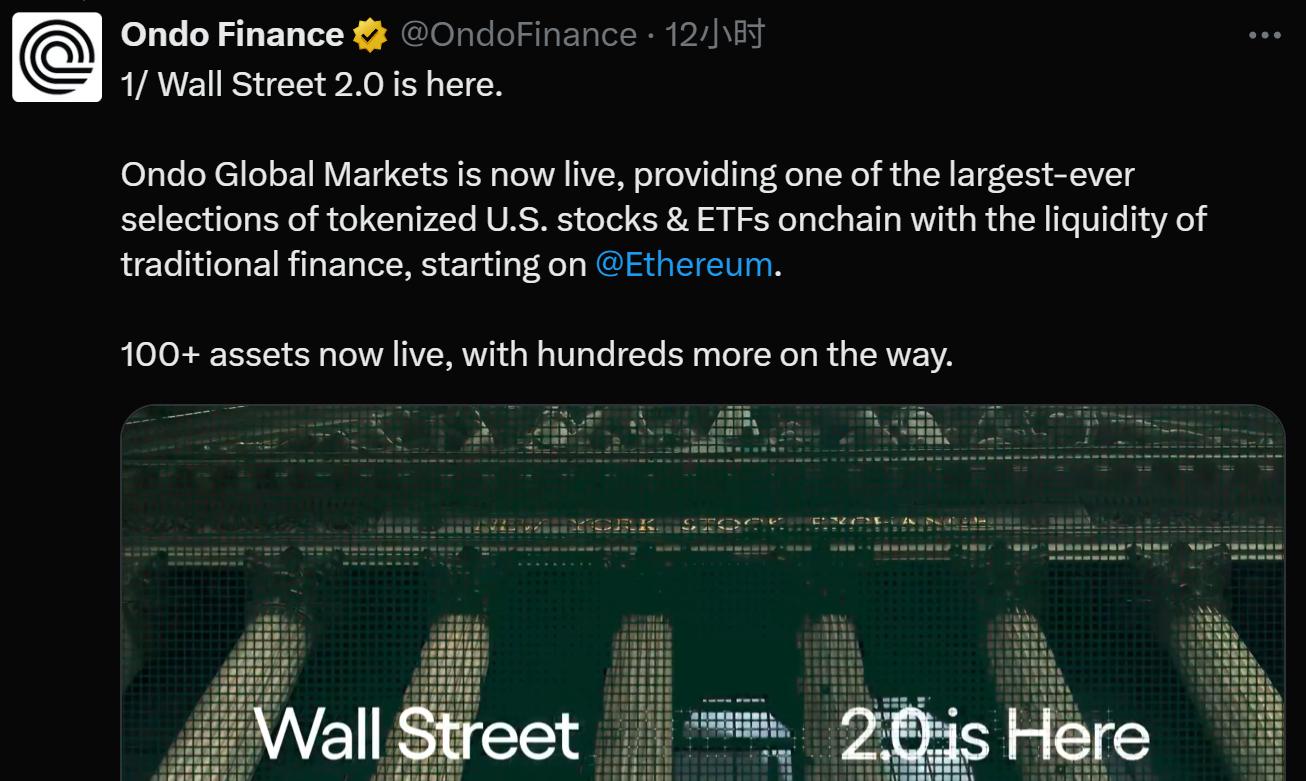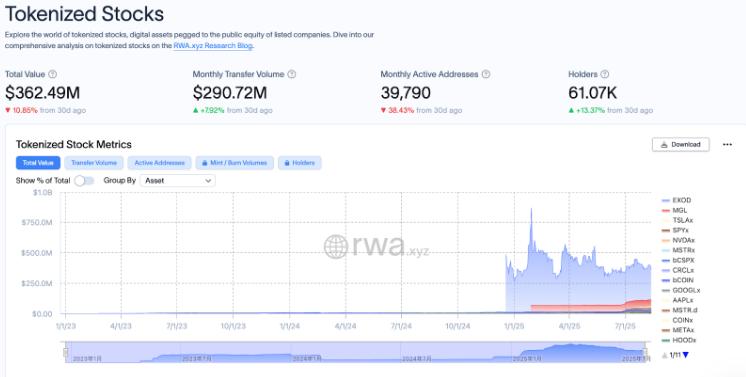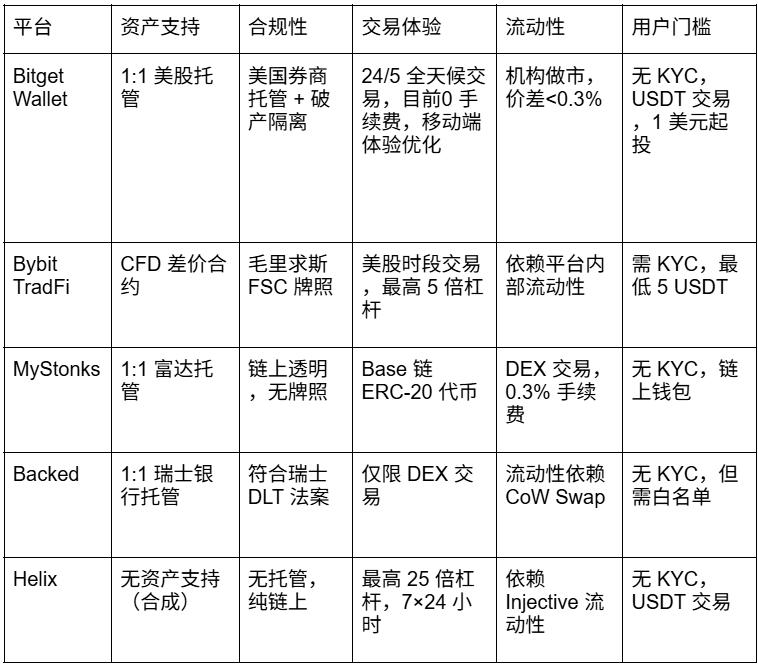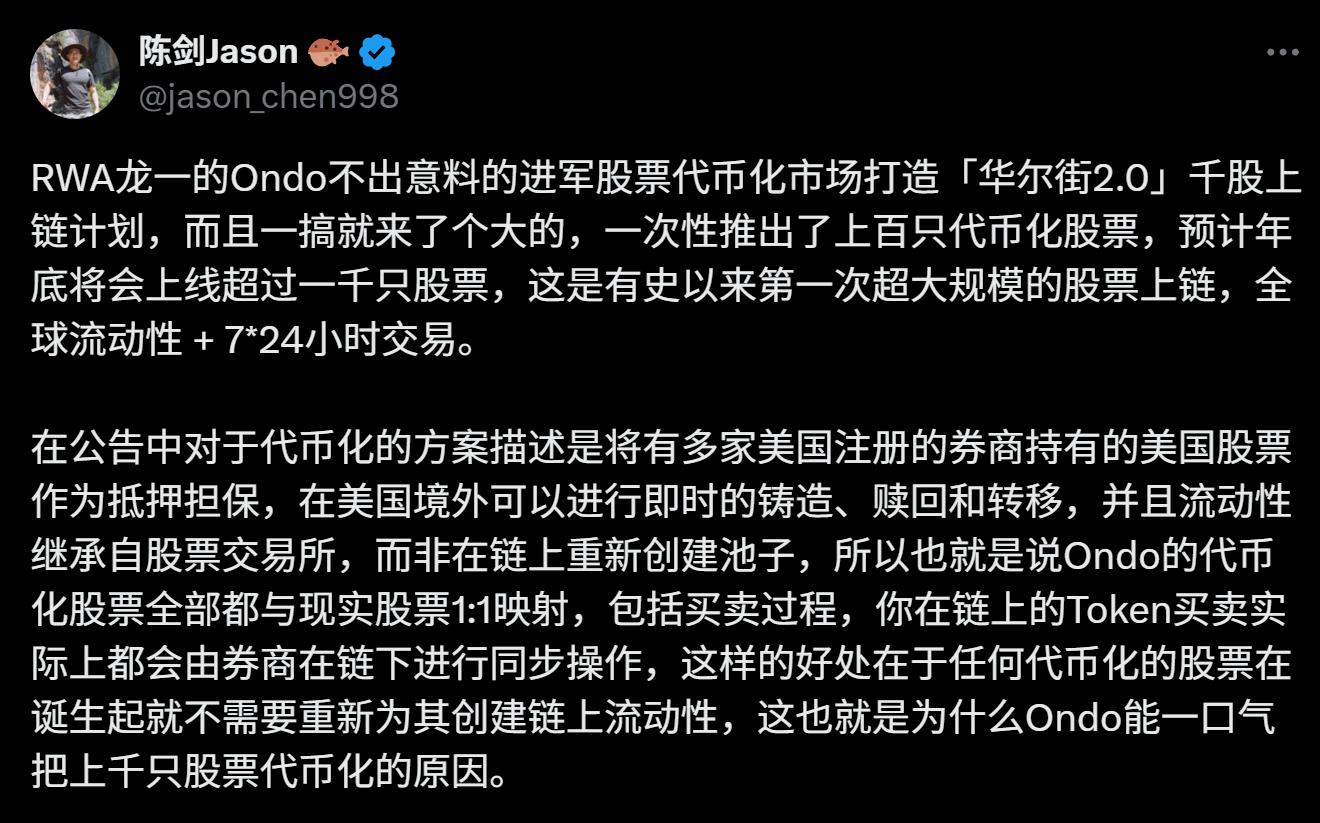From synthetic assets to CFDs and then to physical stock custody, how do compliance, liquidity, and user experience compete?
Written by Kean
Imagine that when you click "Buy" TESLA tokens in your Web3 wallet, the cooperating brokerage firm off-chain will simultaneously place an order to buy the corresponding number of Tesla shares; and vice versa.
Does this count as moving Wall Street’s investment logic onto the blockchain?
Looking back at the development of tokenized U.S. stocks, there are endless players and different models: from the early days of Mirror and Synthetix using synthetic assets, to derivatives trading of contracts for difference (CFDs), to today's platforms such as Robinhood and MyStonks trying to custody real stocks, tokenized U.S. stocks have always been groping between different paths.
The latest radical exploration comes from Ondo Finance, which adopts a more direct "on-chain instructions, off-chain real stock synchronous trading" model. The purchases and sales completed by investors on the chain will be executed in real time off-chain by the cooperating brokerage. This means that tokenized stocks do not need to rely on additional on-chain liquidity pools and naturally have the potential for large-scale expansion.

As of the time of writing, Bitget and Bitget Wallet have taken the lead in completing integration with Ondo, allowing users to trade hundreds of tokenized US stocks and ETFs directly through Bitget Wallet's on-chain portal, further reducing investment accessibility and posing as a game-changer.
Synthetic assets, CFD contracts for difference, real stock custody, and instant linkage between on-chain and off-chain have brought the tokenized US stock market to a new watershed.
1. Wall Street on the Blockchain: The 21st Century American Dream
In the 19th century, the American Dream was the California Gold Rush and the freedom of the New World.
In the 20th century, the American dream was transatlantic immigration, "all men are created equal," and the struggle for a happy life.
In a sense, tokenized U.S. stocks are the 21st-century "American Dream." They not only embody global investors' vision of financial freedom but also extend the influence of the U.S. capital market—bringing the pulse of Nasdaq to every connected corner of the globe, strengthening the dollar's role as a clearinghouse, expanding its reach, and ensuring that Wall Street continues to control the rules in a borderless digital world.
Looking back, from the pioneering RWA concept and practice by MakerDAO and Centrifuge to the initial attempts by STOs like Polymath to bring Wall Street rules to blockchain, tokenized US stocks have long been considered the RWA form most aligned with public investment habits and easiest to implement. However, the STO craze quickly faded due to regulatory uncertainty, insufficient liquidity, and weak technology.
The turning point occurred in 2020, when DeFi Summer proved the feasibility of on-chain liquidity, and the popularity of stablecoins provided a solid anchor for cross-border settlement and asset pricing.
- Mirror Protocol and Synthetix launch on-chain US stock synthetic assets
- FTX and Binance are collaborating with licensed brokerages to launch tokenized US stock trading that is anchored to real US stock prices.
However, with the collapse of FTX and tightening global regulations, on-chain liquidity gradually dried up, and most tokenized stock businesses on the CEX and DeFi sides were forced to go offline.
In 2023, the Federal Reserve embarked on its most aggressive interest rate hike cycle in 40 years, sending US Treasury yields soaring and capital returning to favoring high-yield, low-risk assets. MakerDAO transitioned to a RWA model based on US Treasuries. With regulatory frameworks in place in Hong Kong and other regions, traditional financial institutions began experimenting with compliant tokenized securities.
Today, RWA has achieved breakthroughs in regulation, technology, and products , and tokenized US equities are re-entering a growth trajectory. According to RWA.xyz data, as of August 13th, the total value of tokenized equities reached approximately $362 million, spanning 167 asset classes, with approximately $290 million in monthly trading volume and over 60,000 holders.
This number may not be huge, but it marks a trend - the liquidity edge of US stocks is being quietly rewritten by the on-chain world.

2. Who is tokenizing US stocks?
After several years of trial and error, participants in the tokenized US stock market are gradually taking shape, forming a differentiated landscape in terms of compliance paths, technical architecture, and liquidity strategies. Currently, there are four representative platforms in the market:
Bybit TradFi
Currently, the Bybit MT5 Gold & FX platform has launched US stock CFDs, initially supporting 78 US-listed stocks and offering up to 5x leverage. CFDs are derivative contracts that allow investors to trade and profit from price differences without actually holding the underlying asset, but they carry a relatively high level of risk and volatility.
Crypto users can use Bybit simply by registering and completing KYC Level 2 certification. However, Bybit MT5 only holds a license issued by the Financial Services Commission of Mauritius and currently does not cover major markets such as the EU, UK, and US.
MyStonks
MyStonks, a decentralized RWA trading platform, officially launched its on-chain US stock token market on May 10th, fully backed by Fidelity's custody. Users deposit USDT/USDC into MyStonks, which then converts them into US dollars and purchases the corresponding stocks. These are then minted as ERC-20 tokens on Base at a 1:1 ratio. MyStonks supports direct login via Web3 wallets. MyStonks recently completed US STO compliance filings, allowing it to issue compliant security tokens.
Backed Finance (Swiss Compliance License + DeFi Access)
Backed Finance is a tokenized asset issuer headquartered in Zurich, Switzerland, holding a Swiss regulatory compliance license. Its issued tokens are 1:1 aligned with real assets and are held in custody by Swiss banks. Backed has launched xStocks, a tokenized stock product, which can be traded on CEXs like Bitget and Kraken, as well as Solana DeFi. xStocks tokens support cross-chain transactions and are usable on ETH, Base, Gnosis, Arbitrum, Avalanche, Optimism, BSC, Sonic, and Polygon. Backed does not require user KYC, though whitelisting is currently required.
Helix
Helix, a DEX within the Injective ecosystem, has launched iAssets, a synthetic asset platform. Recently, it launched trading for 13 US stock synthetic assets. iAssets are essentially on-chain derivatives, not backed by physical shares. They track the prices of US stocks through smart contracts and oracle quotes. Users are required to deposit USDT stablecoins as margin, offering up to 25x leverage.
Unlike the aforementioned platforms, Bitget Wallet is the first Web3 wallet to tokenize US stocks. Combining trading access and asset management, it simplifies the onboarding process for Web2 users while also aggregating multi-chain DeFi, allowing users to trade US stock tokens directly with their on-chain identities, eliminating the need for complex KYC procedures.
More importantly, Bitget Wallet directly cooperates with Ondo to introduce a real asset custody path, and joins hands with professional market makers to provide liquidity depth close to that of traditional brokerages.

3. Differentiation Path of Tokenized US Stocks
From an overall perspective, the current competition among tokenized US stock platforms mainly shows differentiation in three dimensions: asset support and compliance, liquidity, and user accessibility.
1. Real assets and compliant custody
The first is naturally the synthetic asset model that started with Synthtix, Mirror, etc. This solution is highly flexible, but there is no real asset support behind it. Users need to bear the counterparty risk themselves. Ultimately, price anchoring ≠ asset ownership. US stocks minted and traded under the synthetic asset model do not represent actual ownership of the stocks in reality.
Once the oracle fails or the collateral assets collapse (Mirror collapsed due to the collapse of UST), the entire system will face the risk of liquidation imbalance, price decoupling, and collapse of user confidence.
The contract for difference (CFD) model like Bybit tends to be high-leverage and derivative trading, which is closer to the traditional foreign exchange trading method. The license coverage is limited and there are certain gray areas.
The Bitget Wallet model has more advantages - through Ondo's cooperation with a US registered brokerage firm, the token is linked to real US stocks at a 1:1 ratio and audited daily, avoiding the "paper token" risk that exists on some platforms and being more resilient under regulatory trends.
2. Liquidity optimization capabilities
Liquidity directly determines user experience. Backed, MyStonks, and others rely heavily on on-chain DEX spot pools, which are susceptible to limitations in the volume and slippage of a single trading pair, leading to insufficient trading stability.
Helix's iAssets are more inclined towards the leveraged derivatives market, which can indeed attract a certain amount of trading activity in the short term, but the long-term stability of this high-volatility, high-leverage model remains questionable.
Interestingly, Bitget Wallet's TradFi integration approach is based on the Ondo model of "on-chain instructions, off-chain simultaneous stock trading" mentioned at the beginning of this article. This allows for instant minting, redemption, and transfers outside the United States. As researcher Chen Jian noted, "The advantage of this is that any tokenized stock does not require the creation of new on-chain liquidity from the outset, which is why Ondo has been able to tokenize thousands of stocks at once."
At the same time, it uses institutional market makers such as Jump Crypto to provide depth and spreads on the chain close to those of traditional brokerages (<0.3%). This two-tier mechanism of "off-chain real stock synchronization + on-chain institutional liquidity" allows users to enjoy lower transaction friction while avoiding the common problems of insufficient liquidity and slippage in the DeFi model.

3. User Threshold and Global Accessibility
For investors in emerging markets, the synthetic asset model offers the lowest barrier to entry and global accessibility: trading requires only an on-chain wallet, with no identity verification required. However, this convenience comes at the cost of a lack of real asset backing, placing the risk entirely on the user.
Bitget Wallet's model followed closely behind. It offers a "no KYC + USDT trading + $1 minimum investment" entry point, significantly lowering the barrier to entry while ensuring asset security through Ondo's physical custody.
In comparison, although Bybit has certain advantages in liquidity, its user coverage is limited due to the nature of CFDs and mandatory KYC; although Backed supports multi-chain and cross-chain, it currently still requires a whitelist application and its openness is limited.
It can be said that at this stage, Bitget Wallet has taken a completely different path from synthetic asset DEX, CFD platform, and traditional RWA protocol by virtue of its combination of "real asset custody + high liquidity + low threshold". This model not only responds to the regulatory compliance trend's requirements for asset security, but also takes into account the convenience of participation of global users to a certain extent.
However, while Ondo's advanced physical stock custody model, combined with Bitget Wallet's traffic portal, strikes a good balance between asset security, liquidity, and accessibility, and creates certain differentiated advantages, the entire track still faces three major challenges:
- Cross-border regulatory uncertainty: Even with U.S. brokerage custody, cross-border sales of security tokens may still trigger compliance requirements in different jurisdictions.
- Market education and liquidity guidance: How to get more traditional investors to accept on-chain US stock products and maintain a stable liquidity depth is a test for long-term operations.
- Gray Areas in Tax Rules: Taxation is an invisible but crucial variable. Capital gains and dividend taxation on US stocks on-chain is not standardized across different countries, and uncertainty remains as to whether and how the US Internal Revenue Service (IRS) will track on-chain transactions. This means platforms must not only provide trading services in compliance but also provide users with clear tax guidance to truly lower the barrier to entry.
Overall, the tokenized U.S. stock market is moving from the "experimental stage" to "model differentiation." Whoever can simultaneously solve the three major issues of compliance, liquidity, and accessibility will be more likely to break through.








